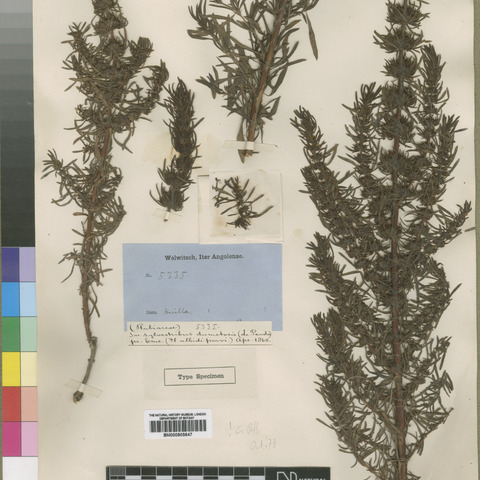Dioecious shrub, single-or (seldom) several-stemmed, ± erect, c. 1-3 m tall. Stems mostly much branched above, branches usually ± regular, paired, often ascending. Leaves decussate, mostly pseudoverticillate; blades (7-)10-35 x (1-)1.5-3.5 mm, (narrowly) oblanceolate, elliptic to ± linear-lanceolate, mostly glabrous; petioles ±0-1 mm long; stipular sheath with 3-5(-7.8) setae, the longest c. (0.5-)0.7-4.5(-5.6) mm. Flowers subsessile to shortly pedicellate (pedicels to 0.7 mm in 'male'), in clusters of many (very many: 'female') at nodes, inflorescences dimorphic, in 'female' often quite contracted, dense, ± cylindrical inflorescence zones; corolla 4-merous, greenish yellow to pale yellow, occasionally purplish tinged outside, mostly glabrous. 'Male': tube (0.5-)0.7-1.2 mm long, funnel-shaped, lobes (1.2-)1.5-2.2(-2.7) x (0.4-)0.6-0.9(-1.1) mm; anthers 1-2 mm long; small rudimentary ovary with 4 minute calyx lobes. 'Female': tube 0.2-0.5 mm long, lobes 0.2-0.7 x 0.1-0.2 mm; style ±0-1 mm long, stigmas 2, 3-7.5(-10) mm long; ovary c. 0.6-1 x 0.3-0.6 mm, with 4 sometimes unequal calyx lobes. Fruit mostly reddish brown, shiny; mericarps 1.5-2.7 x 0.7-1.2 mm, oblong, elliptic to ± obovate, glabrous or (seldom) ± sparsely shortly hairy, with 2 ± triangular calyx lobes c. (0.3-)0.5-1(-1.2) x 0.2-0.5 mm, one occasionally longer than the other.
A robust suffruticose herb; stem erect, reddish, glabrate, closely branched, 2 ft. high or more; branches spreading at an angle of about 45° with the stem, puberulous towards the extremities, densely leafy; leaves sub-linear or sub-spathulate, apiculate at the apex, narrowed gradually to the sub-sessile base, uni-nerved at the base, glabrous or very nearly so, minutely or obsoletely scaly especially beneath, rigid, opposite, with abbreviated leafy branchlets in the axils giving the leaves a fasciculate appearance, 1/3 to 1 1/4 in. long, margins revolute; stipules truncate, 3-to 5-cuspidate, joining the very short petioles or leaf-bases; flowers sub-sessile, tetramerous, whitish, small; calyx-limb green, quadripartite; the segments lanceolate or subulate, shorter than the corolla-tube in the male flowers, glabrous; corolla of the male flowers funnel-shaped; the lobes lanceolate, twice as long as the tube, valvate in the bud, spreading in full flower; stamens 4, glabrous; anthers ellipsoidal-oblong; cells 2, separated at the base for some distance up to the point of attachment of the filament at the back; filaments slender, filamentous, inserted about the middle of the corolla-tube; style elongated, slender, puberulous, bifid at the apex.
Shrub, 1-3 m high, dioecious. Leaves decussate; oblanceolate to elliptic, (7-)10-35 x (1,0-)1,5-3.5 mm, glabrous. Stipular sheaths with 3-5(-7 or 8) setae. Female plants with conspicuous, condensed cylindrical inflorescences. Mericarps oblong, elliptic to obovate, glabrous or sparsely hairy. Flowers greenish yellow to pale yellow, occasionally purplish tinged outside.
Flowers subsessile to shortly pedicellate (pedicels to 0.7 mm. in male), in clusters of many (very many: female) at nodes, inflorescences dimorphic, in female often quite contracted, dense, ± cylindrical inflorescence zones; corolla 4-merous, greenish-yellow to pale yellow, occasionally purplish ringed outside, mostly glabrous.
Leaves decussate, mostly pseudo-verticillate; blades 10–35 x (1)1.5–3.5 mm., (narrowly) oblanceolate, elliptic to ± linear-lanceolate, mostly glabrous; margins ± flat; petioles 0–1 mm. long; stipular sheath with 3–5(7,8) setae, the longest (0.5)0.7–4.5(5.6) mm.
Fruit mostly reddish-brown, shiny; mericarps 1.5–2.7 x 0.7–1.2 mm., oblong, elliptic to ± obovate, glabrous or (seldom) ± sparsely shortly hairy, with 2 ± triangular calyx lobes (0.3)0.5–1(1.2) x 0.2–0.5 mm., one occasionally longer than the other.
Female: tube 0.2–0.5 mm. long, lobes 0.2–0.7 x 0.1–0.2 mm.; style 0–1 mm. long, stigmas 3–7.5(10) mm. long; ovary 0.6–1 x 0.3–0.6 mm., with 4 sometimes unequal calyx lobes.
Male: tube (0.5)0.7–1.2 mm. long, funnel-shaped, lobes (1.2)1.5–2.2(2.7) x (0.4)0.6–0.9(1.1) mm.; anthers 1–2 mm. long; small rudimentary ovary with 4 minute calyx lobes.
Stems mostly much-branched above, branches usually ± regular, paired, often ascending, glabrous to very shortly hairy.
Dioecious shrub, single-or (seldom) several-stemmed, ± erect, 1–3 m. tall.

